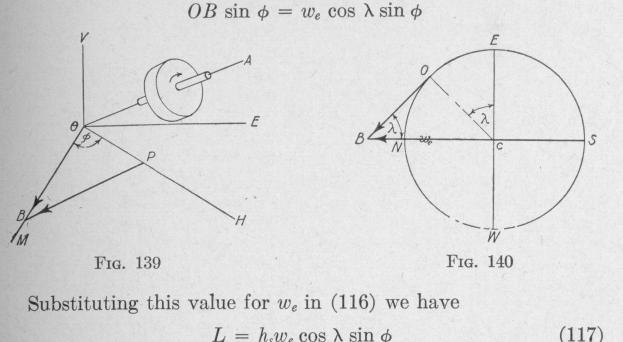178 NAVIGATIONAL COMPASSES
the spin-axle will move into and remain in the meridian plane. The required damping can be effected by a torque that will either (a) diminish the tilt of the spin-axle from the horizontal, or (b) oppose the horizontal motion of the spin-axle. The oscillation of the spin-axle of a gyro spinning in the same direction as the rotation of the earth can be damped by means of a viscous liquid. The magnitude of the damping torque should be proportional to the instantaneous angular speed of the gyro-axle about the axis of the torque.
109. The Meridian-Seeking Torque Acting on a Gyro-Compass. - The spin-axle of a gyro-compass is kept approximately horizontal by either a pendulous mass or a mercury ballistic. Freedom of rotation of the gyro about a horizontal axis perpendicular to the spin-axle is partially suppressed by a torque that is developed when the spin-axle is turned. If a gyroscope with one degree of rotational freedom either wholly or partially suppressed be rotated, the spin-axle will tend to set itself in the direction of the axis of rotation (Art. 49). Consequently, the spin-axle of a stationary gyrocompass on the earth tends to set itself parallel to the horizontal component of the earth's angular velocity at the place where the compass is situated.
When the spin-axle and the axis about which the instrument is being rotated are perpendicular to one another, the torque tending to turn the gyro-axle has the value (Art. 36):
L = Kswswe = hswe (116)
where we represents the angular velocity of the earth about the polar-axis.
The magnitude of the torque urging the spin-axle toward the meridian plane when the gyro-compass is at latitude X, and the spin-axle is inclined to the meridian plane at the angle 0, is obtained by substituting for we the value of the component of the angular velocity of the earth with respect to a horizontal line perpendicular to the vertical plane that contains the spin-axis. In Fig. 139, the spin-axle of the gyro is in the direction AO, with respect to a system of rectangular coordinates consisting of a vertical VO, a horizontal line MO in the meridian, and a horizontal east-and-west line EO. A vertical plane containing the spin-axle intersects the horizontal plane MOE in the line HO. The vertical plane VOH is inclined to the meridian plane VOM at the angle o.
THE VARIOUS TYPES 179
At a point 0 on the earth at latitude X, Fig. 140, the component angular velocity of the earth with respect to a horizontal axis OB in the meridian plane at 0 is we cos X. In Fig. 139, this component is represented by the line OB. The component of OB about a horizontal axis PB perpendicular to the vertical plane VOH containing the spin-axle of the gyro-wheel is
This is the magnitude of the torque urging the spin-axle of a stationary gyro-compass toward the meridian. It depends upon the angular momentum of the gyro, upon the latitude and upon the angle between the spin-axle and the meridian. The meridian-seeking torque is so small, especially when the gyro-compass is at a place of high latitude and the spin-axle makes a small angle with the meridian, that unusual methods must be adopted to reduce the opposing torque due to the method of suspending the sensitive system.
For the passage under the ice to the North Pole, Sir Hubert Wilkins' Nautilus was equipped with a gyro-compass. Now the directive tendency of the sensitive element of a gyro-compass produced by a constant precession toward the meridian is too small to be effective at latitudes greater than about 85 degrees. Consequently, when near the Pole, the compass gyro was disconnected from the precessing device and the gyro left as free of all restraint as possible. In this condition, the spin-axle holds its direction in space instead of maintaining its position in a meridian of the earth. The spin-axle moves away from the meridian, to
which the spin-axle was parallel at the instant the gyro was dis-
